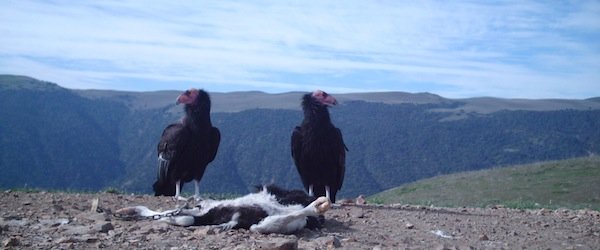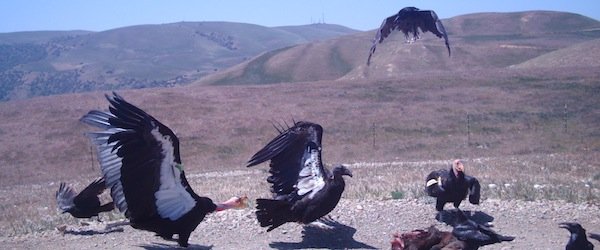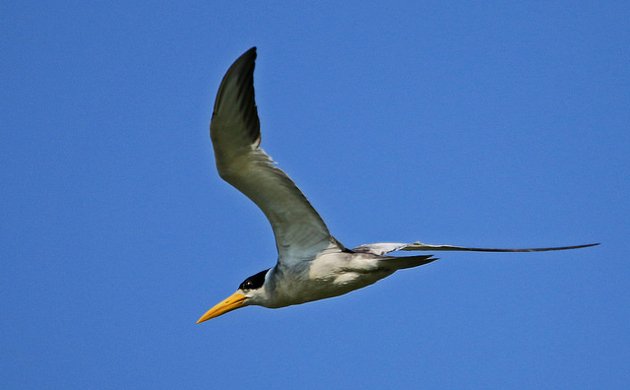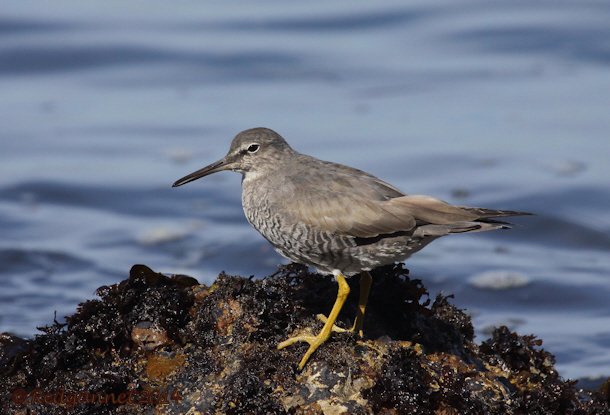Birders who have seen California Condors in the wild in the last 20 years should know just how lucky they are. And the condors themselves should count themselves even luckier. But to label the massive conservation effort that saved the California Condor from certain extinction as “luck” would be a serious disservice to the individuals who worked so hard to make this miracle happen. In March 2009, our TV crew joined conservation officers from the US Fish and Wildlife Service to film condors at the Bitter Creek National Wildlife Refuge in Kern County, California.
Bitter Creek varies in elevation from a thousand feet right up to nearly 5,000 feet and, whilst driving the snow-flanked roads to get to the refuge, I realized I was seriously under-dressed in shorts and a t-shirt. I’m the perfect example of why South Africans account for 82% of all deaths from exposure in the United States. Bitter Creek is dramatically beautiful, the result of a landscape continuously sculpted by sub-terranean upheaval. Bitter Creek is bisected by the San Andreas Fault and I could have sworn I kept feeling tremors the entire time we were there filming. But that might also have had something to do with the shorts and t-shirt. The 14,000 acre Bitter Creek National Wildlife Refuge was purchased to protect the rapidly disappearing condor habitat in 1985. It is also the site where the last wild condor was caught in 1987 and recruited into the ambitious condor breeding project, a co-operative effort involving various organizations including the San Diego Wild Animal Park, the Los Angeles Zoo and the US Fish and Wildlife Service. We caught up with Pete Bloom who caught AC 9, the last wild condor…
Today, reintroduced condors thrive on the refuge but human hands still mould and shape the lives of these majestic birds – sadly, perhaps forever. In addition to the condors, the varied habitats of Bitter Creek also provide refuge for Federally-listed endangered species like the San Joaquin Kit Fox, Giant Kangaroo Rat, Blunt-nosed Leopard Lizard and Tri-colored Blackbirds, a bird which has experienced a massive decline over the last 30 years. Before we went searching for wild California Condors, we were escorted to the flight pen where birds from the breeding project are acclimatized to their surroundings before being released. There happened to be a young condor there at the time and I got the chance to enter the pen and get acquainted with North America’s largest bird. It felt like stepping into the ring with The Undertaker, of wrestling fame. In fact there are many similarities between condors and The Undertaker. They both wear black, both are insanely massive and both have a reputation for disposing of dead bodies. Except I don’t ever recall The Undertaker urinating on his legs to cool himself down but I only watched a few of his bouts…
After spending time with the captive condor, we set off with telemetry to try track the wild birds. We had some nice distant looks of a few birds flying and also some great distant looks at adult birds at one of the feeding stations. Due to their nervousness at the feeding sites we were required to keep our distance and the Fish and Wildlife guys suggested we try get closer footage of the birds at one of the roosting sites. So the Fish and Wildlife guys set up our trusty Birdcam at the feeding station and we set off to try find birds coming into roost. When we reviewed the photos from the Birdcam we were thrilled to find some stunning images of condor interaction.
 Two Condors survey their surrounding before approaching the feeding station
Two Condors survey their surrounding before approaching the feeding station
 Condors squabble over the remains of a carcass at Bitter Creek National Wildlife Refuge
Condors squabble over the remains of a carcass at Bitter Creek National Wildlife Refuge
Condors are clever birds and they tend to roost at some pretty inaccessible sites. After several hours of fruitless searching, the telemetry finally picked up a single bird. As the sun dipped behind the hills and the temperature plummeted we walked until the signal indicated that the bird was less than a hundred yards from us and directly below us on a steep incline. But we could not see a thing. We tried getting a view from the other side but our view was impeded. Eventually we had no choice but to risk life and limb by climbing straight down the incline, much to my cameraman, Aderman’s dismay. But we finally sat in the frigid mountain air directly level with a young wild condor. The dusky sky was a beautiful, indescribable hue – not quite purple and not quite blue. The air was silent except for the sound of our breath. And a California Condor settled in for the night, awaiting a new dawn.
California Condor timeline:
1890s approximately 600 California Condors remain in the wild
1967 Listed as federally endangered
1975 Recovery program established
1982 Only 22 birds remain and the captive breeding program begins; first condor born in captivity
1987 Last wild condor, AC 9 is captured
2000 First wild-born condor is released back into the wild
2002 First chick is born in the wild after 18 years; AC 9 is released back into the wild.
2010 380 condors exist, with nearly 200 of them at wild sites in California, Mexico and Arizona





 New writers welcome – please contact us for details.
New writers welcome – please contact us for details.

















Wow, great post James. I’m somehow more jealous of you getting access like this than I am about – er, actually, you know, forget it, I’m just jealous of everything you get to do 🙂
its better more and more people are doing this. thats what the birds need to survive.
I SOMETIMES WONDER IF PIT TRAPS WOULD WORK FOR GETTING A GIRLFRIEND?
@Jeff Aderman: Only if you take off the bright yellow sneakers…
Interesting post James, you are a Cali Condor VIP! I know from reading your work that you are a witty guy, so I have to assume that “South Africans account for 82% of all deaths from exposure in the United States” is joke. If it wasn’t a joke, we should talk about layering sometime, even in Kern Co.
@YourBirdOasis: I got that stat by asking my 7-year old to guess a number, any number, between 0 and 100.